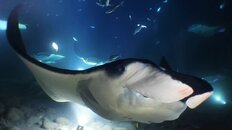@Fogtownboy
Take your strobes. I've done this dive numerous times (mostly off the [now old] Kona Aggressor)...
If you are shooting stills you will want your strobes. Some of the advice above is good, some of it is focused on video (only), and some seems fairly inexperienced.
You will be on the sand, which means that most of the backscatter will be your own doing (or your buddy's). Be as still as you can, and try to get away from other divers (but not so far away you can't shoot images).
In addition to the strobes, mount the strongest spotting light you have to the top of your housing. The mantas feed in the light because it attracts the "food" - the mantas seem to be able to distinguish between stronger lights and weaker lights - they definitely will tend to get closer to stronger light sources. You're not trying to compete with whatever lights are being used (either from the surface for the snorkelers, or from the bottom for divers), you want a strong light so that when the mantas circle around the outside some of them come very close to you.
Last bit of advice (learned this first hand from one of the DM's on the Aggressor): after you settle in on the sand (around the boundary) you can spend 15-20 min watching/shooting all the mantas circling above the center, but after you get over the initial excitement...
Back up 10-15 feet, lie on your back directly on the sand, and point your light straight up. You will find several of the mantas will start swimming through your light (as they circle around), and you will get some great "personal" manta image opportunities.
These will be different images (not the 3-5 mantas in an image all feeding), but very close "flyby's" right above you.
DM showed me this trick and I've used it more than 1/2 dozen times...




